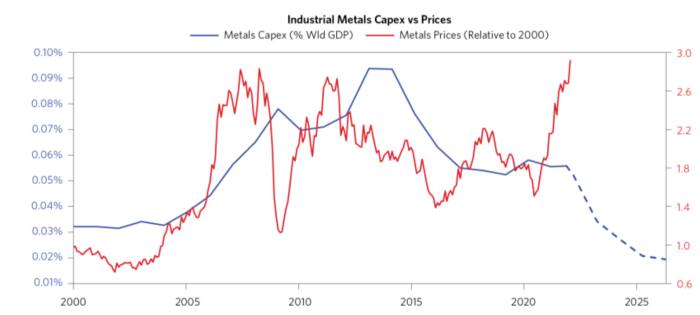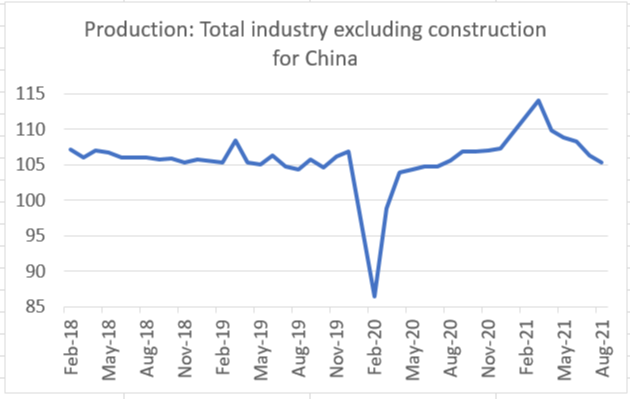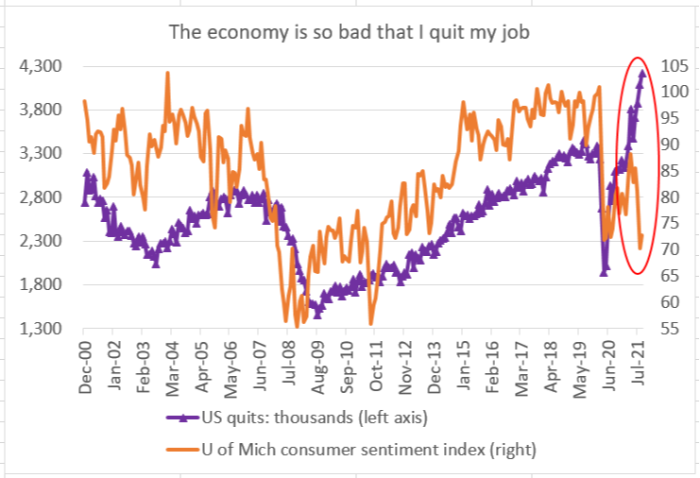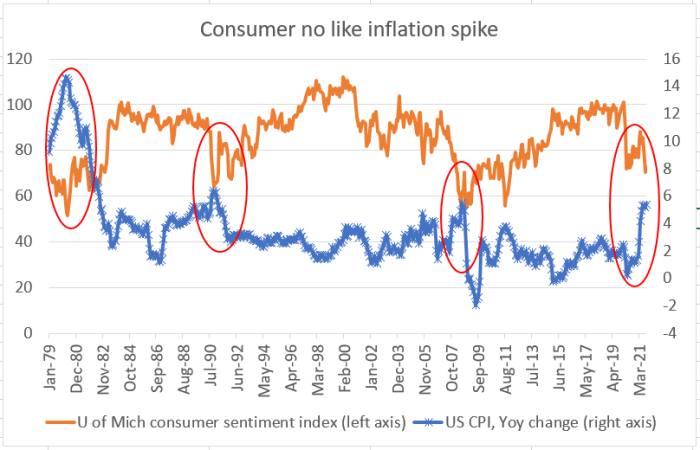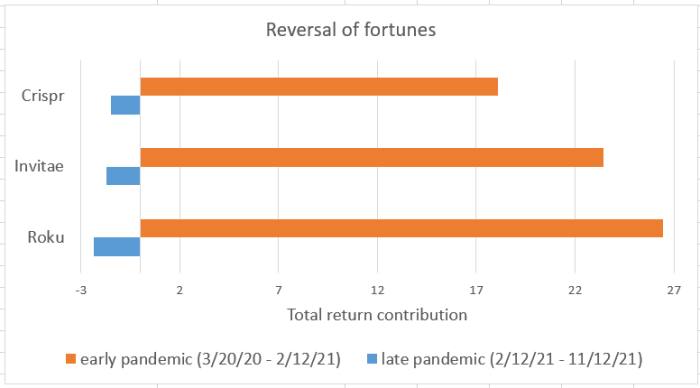[ad_1]
This article is an on-site version of our Unhedged newsletter. Sign up here to get the newsletter sent straight to your inbox every weekday
Good morning. Inflation is back at the top of the agenda, if the Sunday papers are any indication. So we have two pieces on it today, along with one about deflation — specifically, the deflation in Cathie Wood’s Ark Innovation fund. Email me robert.armstrong@ft.com or Ethan at ethan.wu@ft.com.
What if it’s just a demand shock?
This paper from Bridgewater has gotten a lot of attention ever since it was published about a month ago. It’s a fun read, and sums up the views of the inflation-is-not-transitory team very briskly. The core argument is that the supply chain bottlenecks everyone is rattling on about are no big deal. The big deal is the massive demand spike caused by fiscal and monetary stimulus. Here’s the gist:
Supply of almost everything is at all-time highs . . . this is mostly [a policy] driven upward demand shock. And while some drivers of higher inflation have been transitory, we see the underlying demand/supply imbalance getting worse, not better . . .
There are still large stockpiles of latent spending due to the transformative effects that [policy] has had on balance sheets and the ongoing incentive provided by extremely low real yields, and more fiscal stimulus is on the way. Choking off demand would require central banks globally to move toward restrictive policies quickly, which looks unlikely . . . There are not enough raw materials, energy, productive capacity, inventories, housing, or workers.
The gap between demand and supply is now large enough that high inflation is likely to be reasonably sustained
The piece is full of intriguing charts. Two in particular exemplify the argument. Here is nominal demand vs global supply of goods for US consumption:
(One slightly frustrating thing is that specific data sources for the charts are not given — there is just one big footnote at the end with dozens of data sources in it. More on that below.) Next, a chart of an industrial metals index against a capital spending/GDP ratio:
There are a bunch of other charts making similar points about services, employment, energy, inventories, shipping, housing, and so on.
If the argument is correct, how is it important for markets? It certainly suggests that the reflation trade — broadly, the idea that cyclical assets are going to outperform — is going to be around for a while yet (barring a violent, growth-killing intervention by central banks). It’s less clear to me if it suggests an obvious bond trade. We have seen a big move up in the belly of the Treasury curve. The five year is up 46 basis points since mid-September, but the ten year has moved less, and the thirty year is flat. That is consistent with a bulge in demand and a flurry of inflation that subsides in just a few years, a scenario which might fit with the Bridgewater view.
In any case, some thoughts and questions on the argument:
-
No one denies that stimulus-driven demand is an important part of what is going on right now. Consumer and corporate balance sheets look great. The interesting question is whether Bridgewater is right that bottlenecks (outside of a few areas like cars) are not an important part of the story. The only bottlenecks that Bridgewater thinks are really important are in labour (a shortage caused by stimulus, that is, by worker “leverage”) and supply problems that predate the pandemic, in energy and US housing.
-
I’m not sure what Bridgewater means by “nominal demand” (they could not make anyone available last week to talk to me about the paper) but if it corresponds roughly to disposable personal income (as suggested to me by Skanda Amarnath at Employ America), it looks like that is going to roll over soon, because there is not going to be another round of stimulus cheques and enhanced unemployment benefits. The paper predicts inflation will be “reasonably sustained” but does not provide a timeframe. Is the argument consistent with inflation subsiding in the second half of next year, which seems to be Jay Powell’s expectation?
-
I’m wondering if some of the Bridgewater data is already a bit out of date, or has sources I can’t see. Here, for example, is their chart of China industrial production:
This is an odd fit with recent China manufacturing PMI reports showing a contraction, and this OECD index of China industrial production showing change versus a year ago:
Similarly, metals prices are not heading straight north. It is surely important to the inflation debate that, for example, aluminium prices have fallen by 14 per cent in less than a month; copper prices have been flat since May; and iron ore prices have fallen by half since this summer. Prices did take a big step up during the reopening, but it’s not clear to me that the supply demand imbalance is set to get worse from here, as Bridgewater believes.
A very striking chart
Once again, Unhedged’s wise friend Ed Al-Hussainy of Columbia Threadneedle comes through with a great chart:
People usually quit their jobs when they feel like they have other options and they think the economy is pretty good. Right now, they are quitting in record numbers, but they think the economy absolutely stinks.
There is an explanation. Consumers really, really hate sudden jumps in inflation. Here is a longer-term chart of inflation and consumer sentiment:
Growth vs Ark growth
A lot of people are shorting Cathie Wood’s Ark Innovation ETF. One can see the temptation. After a spectacular 2020, it has not only lagged the market, but lagged most every other flavour of growth investment. It even fell behind the copycat Goldman ETF launched in September to ride Wood’s coattails:
Why doesn’t Ark’s move like other tech/growth bets? Because there is a difference between growth and bleeding-edge growth. Aside from Tesla (10 per cent of the fund), Ark’s most successful bets during the tech-mad early days of the pandemic included Roku, Invitae, and Crispr Therapeutics. These super-long shots have all fallen from among Wood’s top-five performers to the bottom of the table.
Invitae and Crispr Therapeutics are dealing in gene-testing tech that is promising but not fully mainstream. Roku is growing incredibly fast, but faces massive competition for TV screens from the likes of Amazon and Google. None of these companies yet has a deep competitive moat.
By contrast the popular Invesco QQQ ETF, which tracks the Nasdaq 100, is anchored by the FAANGS. Its top performers this year include Microsoft, Nvidia, Alphabet, and Apple. Ark proves that all growth is not the same. (Ethan Wu)
One good read
A moving and important piece by the FT’s Manuela Saragosa about her partner’s suicide. The holidays are a tough time. Be careful out there, everyone.
[ad_2]
Source link



